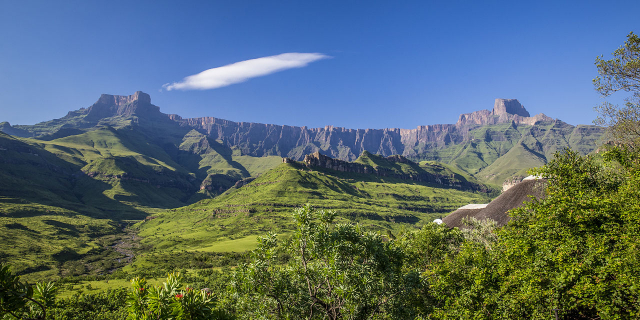Madagascar
Context of Madagascar
Madagascar, officially the Republic of Madagascar, is an island country lying off the southeastern coast of Africa. It is the world's fourth largest island, the second-largest island country and the 46th largest country in the world. Its capital and largest city is Antananarivo.
Madagascar consists of an eponymous main island and numerous smaller peripheral islands. Following the prehistoric breakup of the supercontinent Gondwana, Madagascar split from the Indian subcontinent around 90 million years ago, allowing native plants and animals to evolve in relative isolation; consequently, it is a biodiversity hotspot and one of the world's 17 megadiverse countries, with over 90% of wildlife being endemic. The island has a subtropical to tropical maritime climate.
Madagascar was first settled during or before the mid first millennium AD by Austronesian peoples, presumably arriving on outrigger canoes from present-day Indonesia and Oc...Read more
Madagascar, officially the Republic of Madagascar, is an island country lying off the southeastern coast of Africa. It is the world's fourth largest island, the second-largest island country and the 46th largest country in the world. Its capital and largest city is Antananarivo.
Madagascar consists of an eponymous main island and numerous smaller peripheral islands. Following the prehistoric breakup of the supercontinent Gondwana, Madagascar split from the Indian subcontinent around 90 million years ago, allowing native plants and animals to evolve in relative isolation; consequently, it is a biodiversity hotspot and one of the world's 17 megadiverse countries, with over 90% of wildlife being endemic. The island has a subtropical to tropical maritime climate.
Madagascar was first settled during or before the mid first millennium AD by Austronesian peoples, presumably arriving on outrigger canoes from present-day Indonesia and Oceania (Polynesia, Micronesia and Melanesia). These were joined around the ninth century AD by Bantu migrants crossing the Mozambique Channel from East Africa. Other groups continued to settle on Madagascar over time, each one making lasting contributions to Malagasy cultural life. Subsequently, the Malagasy ethnic group is often divided into 18 or more subgroups, of which the largest are the Merina of the central highlands.
Until the late 18th century, the island of Madagascar was ruled by a fragmented assortment of shifting sociopolitical alliances. Beginning in the early 19th century, most of it was united and ruled as the Kingdom of Madagascar by a series of Merina nobles. The Monarchy was ended in 1897 by the annexation by France, from which Madagascar gained independence in 1960. The country has since undergone four major constitutional periods, termed republics, and has been governed as a constitutional democracy since 1992. Following a political crisis and military coup in 2009, Madagascar underwent a protracted transition towards its fourth and current republic, with constitutional governance being restored in January 2014.
Madagascar is a member of the United Nations (UN), the African Union (AU), the Southern African Development Community (SADC), and the Organization Internationale de la Francophonie. Malagasy and French are both official languages of the state. Christianity is the country's predominant religion, but a significant minority still practice traditional faiths. Madagascar is classified as a least developed country by the UN. Ecotourism and agriculture, paired with greater investments in education, health and private enterprise, are key elements of its development strategy. Despite substantial economic growth since the early 2000s, income disparities have widened, and quality of life remains low for the majority of the population. Madagascar is experiencing an ongoing famine, which experts argue is the first to be caused entirely by climate change.
More about Madagascar
- Currency Malagasy ariary
- Calling code +261
- Internet domain .mg
- Mains voltage 220V/50Hz
- Democracy index 5.7
- Population 25570895
- Area 587295
- Driving side right
- Early period
 Malagasy ancestry reflects a blend of Southeast Asian, Oceanian and Bantu (Southeast African) roots.
Malagasy ancestry reflects a blend of Southeast Asian, Oceanian and Bantu (Southeast African) roots.Traditionally, archaeologists have estimated that the earliest settlers arrived in successive waves in outrigger canoes from Borneo, possibly throughout the period between 350 BCE and 550 CE, while others are cautious about dates earlier than 250 CE. In either case, these dates make Madagascar one of the latest major landmasses on Earth to be settled by humans, predating the settlement of Iceland and New Zealand.[1] It is proposed that Ma'anyan people were brought as laborers and slaves by Javanese and Malays in their trading fleets to Madagascar.[2][3][4] Dates earlier than the mid-first millennium AD are not strongly supported.[5]
...Read moreEarly periodRead less Malagasy ancestry reflects a blend of Southeast Asian, Oceanian and Bantu (Southeast African) roots.
Malagasy ancestry reflects a blend of Southeast Asian, Oceanian and Bantu (Southeast African) roots.Traditionally, archaeologists have estimated that the earliest settlers arrived in successive waves in outrigger canoes from Borneo, possibly throughout the period between 350 BCE and 550 CE, while others are cautious about dates earlier than 250 CE. In either case, these dates make Madagascar one of the latest major landmasses on Earth to be settled by humans, predating the settlement of Iceland and New Zealand.[1] It is proposed that Ma'anyan people were brought as laborers and slaves by Javanese and Malays in their trading fleets to Madagascar.[2][3][4] Dates earlier than the mid-first millennium AD are not strongly supported.[5]
Upon arrival, early settlers practiced slash-and-burn agriculture to clear the coastal rainforests for cultivation. The first settlers encountered Madagascar's abundance of megafauna,[6] including giant lemurs, elephant birds, giant fossa, and the Malagasy hippopotamus, which have since become extinct because of hunting and habitat destruction.[7] By 600 CE, groups of these early settlers had begun clearing the forests of the central highlands.[8]
Arab traders first reached the island between the 7th and 9th centuries.[9] A wave of Bantu-speaking migrants from southeastern Africa arrived around 1000 CE.[10] South Indian Tamil merchants arrived around 11th century. They introduced the zebu, a type of long-horned humped cattle, which they kept in large herds.[11] Irrigated paddy fields were developed in the central highland Betsileo Kingdom and were extended with terraced paddies throughout the neighboring Kingdom of Imerina a century later.[8] The rising intensity of land cultivation and the ever-increasing demand for zebu pasturage had largely transformed the central highlands from a forest ecosystem to grassland by the 17th century.[11]
The oral histories of the Merina people, who may have arrived in the central highlands between 600 and 1,000 years ago, describe encountering an established population they called the Vazimba. Probably the descendants of an earlier and less technologically advanced Austronesian settlement wave, the Vazimba were assimilated or expelled from the highlands by the Merina kings Andriamanelo, Ralambo, and Andrianjaka in the 16th and early 17th centuries.[12] Today, the spirits of the Vazimba are revered as tompontany (ancestral masters of the land) by many traditional Malagasy communities.[13]
Arab and European contacts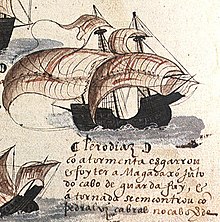 European contact began in 1500 when Portuguese explorer Diogo Dias recorded the island while participating in the 2nd Portuguese India Armadas.
European contact began in 1500 when Portuguese explorer Diogo Dias recorded the island while participating in the 2nd Portuguese India Armadas.Madagascar was an important transoceanic trading hub connecting ports of the Indian Ocean in the early centuries following human settlement.
The written history of Madagascar began with the Arabs, who established trading posts along the northwest coast by at least the 10th century and introduced Islam, the Arabic script (used to transcribe the Malagasy language in a form of writing known as sorabe), Arab astrology, and other cultural elements.[14]
European contact began in 1500, when the Portuguese sea captain Diogo Dias sighted the island, while participating in the 2nd Armada of the Portuguese India Armadas.[15]
Matatana was the first Portuguese settlement on the south coast, 10 km west of Fort Dauphin. In 1508, settlers there built a tower, a small village, and a stone column. This settlement was established in 1513 at the behest of the viceroy of Portuguese India, Jeronimo de Azevedo.[16]
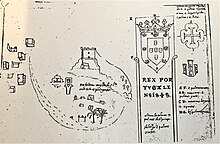 Matatana, represented in a picture of 1613, regarding a settlement of the beginning of the 16th century, in the Book of Humberto Leitão"
Matatana, represented in a picture of 1613, regarding a settlement of the beginning of the 16th century, in the Book of Humberto Leitão"Contacts continued from the 1550s. Several colonization and conversion missions were ordered by King João III and by the Viceroy of India, including one in 1553 by Baltazar Lobo de Sousa. In that mission, according to detailed descriptions by chroniclers Diogo do Couto and João de Barros, emissaries reached the inland via rivers and bays, exchanging goods and even converting one of the local kings.[17]
The French established trading posts along the east coast in the late 17th century.[14] From about 1774 to 1824, Madagascar gained prominence among pirates and European traders, particularly those involved in the trans-Atlantic slave trade. The small island of Nosy Boroha off the northeastern coast of Madagascar has been proposed by some historians as the site of the legendary pirate utopia of Libertalia.[18] Many European sailors were shipwrecked on the coasts of the island, among them Robert Drury, whose journal is one of the few written depictions of life in southern Madagascar during the 18th century.[19]
The wealth generated by maritime trade spurred the rise of organized kingdoms on the island, some of which had grown quite powerful by the 17th century.[20] Among these were the Betsimisaraka alliance of the eastern coast and the Sakalava chiefdoms of Menabe and Boina on the west coast. The Kingdom of Imerina, located in the central highlands with its capital at the royal palace of Antananarivo, emerged at around the same time under the leadership of King Andriamanelo.[21]
Kingdom of Madagascar King Andrianampoinimerina (1787–1810)
King Andrianampoinimerina (1787–1810)Upon its emergence in the early 17th century, the highland kingdom of Imerina was initially a minor power relative to the larger coastal kingdoms[21] and grew even weaker in the early 18th century when King Andriamasinavalona divided it among his four sons. Following almost a century of warring and famine, Imerina was reunited in 1793 by King Andrianampoinimerina (1787–1810).[22] From his initial capital Ambohimanga,[23] and later from the Rova of Antananarivo, this Merina king rapidly expanded his rule over neighboring principalities. His ambition to bring the entire island under his control was largely achieved by his son and successor, King Radama I (1810–28), who was recognized by the British government as King of Madagascar. Radama concluded a treaty in 1817 with the British governor of Mauritius to abolish the lucrative slave trade in return for British military and financial assistance. Artisan missionary envoys from the London Missionary Society began arriving in 1818 and included such key figures as James Cameron, David Jones and David Griffiths, who established schools, transcribed the Malagasy language using the Roman alphabet, translated the Bible, and introduced a variety of new technologies to the island.[24]
Radama's successor, Queen Ranavalona I (1828–61), responded to increasing political and cultural encroachment on the part of Britain and France by issuing a royal edict prohibiting the practice of Christianity in Madagascar and pressuring most foreigners to leave the territory. William Ellis of the London Missionary Society described his visits made during her reign in his book Three Visits to Madagascar during the years 1853, 1854, and 1856. The Queen made heavy use of the traditional practice of fanompoana (forced labor as tax payment) to complete public works projects and develop a standing army of between 20,000 and 30,000 Merina soldiers, whom she deployed to pacify outlying regions of the island and further expand the Kingdom of Merina to encompass most of Madagascar. Residents of Madagascar could accuse one another of various crimes, including theft, Christianity and especially witchcraft, for which the ordeal of tangena was routinely obligatory. Between 1828 and 1861, the tangena ordeal caused about 3,000 deaths annually. In 1838, it was estimated that as many as 100,000 people in Imerina died as a result of the tangena ordeal, constituting roughly 20 percent of the population.[25] The combination of regular warfare, disease, difficult forced labor, and harsh measures of justice resulted in a high mortality rate among soldiers and civilians alike during her 33-year reign; the population of Madagascar is estimated to have declined from around 5 million to 2.5 million between 1833 and 1839.[26]
Among those who continued to reside in Imerina were Jean Laborde, an entrepreneur who developed munitions and other industries on behalf of the monarchy, and Joseph-François Lambert, a French adventurer and slave trader, with whom then-Prince Radama II signed a controversial trade agreement termed the Lambert Charter. Succeeding his mother, Radama II (1861–63) attempted to relax the queen's stringent policies, but was overthrown two years later by Prime Minister Rainivoninahitriniony (1852–1865) and an alliance of Andriana (noble) and Hova (commoner) courtiers, who sought to end the absolute power of the monarch.[14]
Following the coup, the courtiers offered Radama's queen, Rasoherina (1863–68), the opportunity to rule, if she would accept a power sharing arrangement with the Prime Minister: a new social contract that would be sealed by a political marriage between them.[27] Queen Rasoherina accepted, first marrying Rainivoninahitriniony, then later deposing him and marrying his brother, Prime Minister Rainilaiarivony (1864–95), who would go on to marry Queen Ranavalona II (1868–83) and Queen Ranavalona III (1883–97) in succession.[28] Over the course of Rainilaiarivony's 31-year tenure as prime minister, numerous policies were adopted to modernize and consolidate the power of the central government.[29] Schools were constructed throughout the island and attendance was made mandatory. Army organization was improved and British consultants were employed to train and professionalize soldiers.[30] Polygamy was outlawed and Christianity, declared the official religion of the court in 1869, was adopted alongside traditional beliefs among a growing portion of the populace.[29] Legal codes were reformed on the basis of British common law and three European-style courts were established in the capital city.[30] In his joint role as Commander-in-Chief, Rainilaiarivony also successfully ensured the defense of Madagascar against several French colonial incursions.[30]
French colonization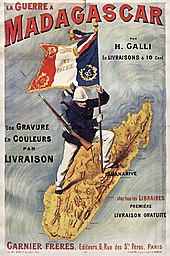 A French poster about the Franco-Hova War
A French poster about the Franco-Hova WarPrimarily on the basis that the Lambert Charter had not been respected, France invaded Madagascar in 1883 in what became known as the first Franco-Hova War.[31] At the end of the war, Madagascar ceded the northern port town of Antsiranana (Diego Suarez) to France and paid 560,000 francs to Lambert's heirs.[32] In 1890, the British accepted the full formal imposition of a French protectorate on the island, but French authority was not acknowledged by the government of Madagascar. To force capitulation, the French bombarded and occupied the harbor of Toamasina on the east coast, and Mahajanga on the west coast, in December 1894 and January 1895 respectively.[33]
A French military flying column then marched toward Antananarivo, losing many men to malaria and other diseases. Reinforcements came from Algeria and Sub-Saharan Africa. Upon reaching the city in September 1895, the column bombarded the royal palace with heavy artillery, causing heavy casualties and leading Queen Ranavalona III to surrender.[34] France annexed Madagascar in 1896 and declared the island a colony the following year, dissolving the Merina monarchy and sending the royal family into exile on Réunion Island and to Algeria. A two-year resistance movement organized in response to the French capture of the royal palace was effectively put down at the end of 1897.[35]
The conquest was followed by ten years of civil war, due to the Menalamba insurrection. The "pacification" carried out by the French administration lasted more than fifteen years, in response to the rural guerrillas scattered throughout the country. In total, the repression of this resistance to colonial conquest caused several tens of thousands of Malagasy victims.[36]
Under colonial rule, plantations were established for the production of a variety of export crops.[37] Slavery was abolished in 1896 and approximately 500,000 slaves were freed; many remained in their former masters' homes as servants[38] or as sharecroppers; in many parts of the island strong discriminatory views against slave descendants are still held today.[39] Wide paved boulevards and gathering places were constructed in the capital city of Antananarivo[40] and the Rova palace compound was turned into a museum.[41] Additional schools were built, particularly in rural and coastal areas where the schools of the Merina had not reached. Education became mandatory between the ages of 6 to 13 and focused primarily on French language and practical skills.[42]
 National monument in Moramanga commemorating the beginning of the Malagasy Uprising on 29 March 1947. Between 11,000 and 90,000 Malagasy died during the uprising which lasted nearly two years.[43]
National monument in Moramanga commemorating the beginning of the Malagasy Uprising on 29 March 1947. Between 11,000 and 90,000 Malagasy died during the uprising which lasted nearly two years.[43]Huge mining and forestry concessions were granted to large companies. Native chiefs loyal to the French administration were also granted part of the land. Forced labor was introduced in favor of the French companies and peasants were encouraged, through taxation, to work for wages (especially in the colonial concessions) to the detriment of small individual farms. However, the colonial period was accompanied by movements fighting for independence: the Menalamba, the Vy Vato Sakelika, the Democratic Movement for Malagasy Renovation (MDRM). In 1927, major demonstrations were organized in Antananarivo, notably on the initiative of the communist activist François Vittori, who was imprisoned as a result. The 1930s saw the Malagasy anti-colonial movement gain further momentum. Malagasy trade unionism began to appear underground and the Communist Party of the Madagascar region was formed. But in 1939, all the organizations were dissolved by the administration of the colony, which opted for the Vichy regime. The MDRM was accused by the colonial regime of being at the origin of the 1947 insurrection and was pursued by violent repression.[44]
The Merina royal tradition of taxes paid in the form of labor was continued under the French and used to construct a railway and roads linking key coastal cities to Antananarivo.[45] Malagasy troops fought for France in World War I.[15] In the 1930s, Nazi political thinkers developed the Madagascar Plan that had identified the island as a potential site for the deportation of Europe's Jews.[46] During the Second World War, the island was the site of the Battle of Madagascar between the Vichy French and an Allied expeditionary force.[47]
The occupation of France during the Second World War tarnished the prestige of the colonial administration in Madagascar and galvanized the growing independence movement, leading to the Malagasy Uprising of 1947.[48] This movement led the French to establish reformed institutions in 1956 under the Loi Cadre (Overseas Reform Act), and Madagascar moved peacefully towards independence.[49] The Malagasy Republic was proclaimed on 14 October 1958, as an autonomous state within the French Community. A period of provisional government ended with the adoption of a constitution in 1959 and full independence on 26 June 1960.[50]
Independent state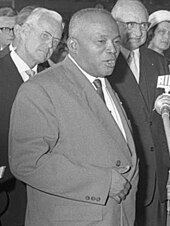 Philibert Tsiranana, the first president of Madagascar (1960–1972)
Philibert Tsiranana, the first president of Madagascar (1960–1972)Since regaining independence, Madagascar has transitioned through four republics with corresponding revisions to its constitution. The First Republic (1960–72), under the leadership of French-appointed President Philibert Tsiranana, was characterized by a continuation of strong economic and political ties to France. Many high-level technical positions were filled by French expatriates, and French teachers, textbooks and curricula continued to be used in schools around the country. Popular resentment over Tsiranana's tolerance for this "neo-colonial" arrangement inspired a series of farmer and student protests that overturned his administration in 1972.[14]
Gabriel Ramanantsoa, a major general in the army, was appointed interim president and prime minister that same year, but low public approval forced him to step down in 1975. Colonel Richard Ratsimandrava, appointed to succeed him, was assassinated six days into his tenure. General Gilles Andriamahazo ruled after Ratsimandrava for four months before being replaced by another military appointee: Vice Admiral Didier Ratsiraka, who ushered in the Socialist-Marxist Second Republic that ran under his tenure from 1975 to 1993.
This period saw a political alignment with the Eastern Bloc countries and a shift toward economic insularity. These policies, coupled with economic pressures stemming from the 1973 oil crisis, resulted in the rapid collapse of Madagascar's economy and a sharp decline in living standards,[14] and the country had become completely bankrupt by 1979. The Ratsiraka administration accepted the conditions of transparency, anti-corruption measures and free market policies imposed by the International Monetary Fund, World Bank and various bilateral donors in exchange for their bailout of the nation's broken economy.[51]
Ratsiraka's dwindling popularity in the late 1980s reached a critical point in 1991 when presidential guards opened fire on unarmed protesters during a rally. Within two months, a transitional government had been established under the leadership of Albert Zafy (1993–96), who went on to win the 1992 presidential elections and inaugurate the Third Republic (1992–2010).[52] The new Madagascar constitution established a multi-party democracy and a separation of powers that placed significant control in the hands of the National Assembly. The new constitution also emphasized human rights, social and political freedoms, and free trade.[14] Zafy's term, however, was marred by economic decline, allegations of corruption, and his introduction of legislation to give himself greater powers. He was consequently impeached in 1996, and an interim president, Norbert Ratsirahonana, was appointed for the three months prior to the next presidential election. Ratsiraka was then voted back into power on a platform of decentralization and economic reforms for a second term which lasted from 1996 to 2001.[51]
The contested 2001 presidential elections in which then-mayor of Antananarivo, Marc Ravalomanana, eventually emerged victorious, caused a seven-month standoff in 2002 between supporters of Ravalomanana and Ratsiraka. The negative economic impact of the political crisis was gradually overcome by Ravalomanana's progressive economic and political policies, which encouraged investments in education and ecotourism, facilitated foreign direct investment, and cultivated trading partnerships both regionally and internationally. National GDP grew at an average rate of 7 percent per year under his administration. In the latter half of his second term, Ravalomanana was criticised by domestic and international observers who accused him of increasing authoritarianism and corruption.[51]
Opposition leader and then-mayor of Antananarivo, Andry Rajoelina, led a movement in early 2009 in which Ravalomanana was pushed from power in an unconstitutional process widely condemned as a coup d'état.[53] In March 2009, Rajoelina was declared by the Supreme Court as the President of the High Transitional Authority, an interim governing body responsible for moving the country toward presidential elections. In 2010, a new constitution was adopted by referendum, establishing a Fourth Republic, which sustained the democratic, multi-party structure established in the previous constitution.[52] Hery Rajaonarimampianina was declared the winner of the 2013 presidential election, which the international community deemed fair and transparent.[54]
In 2018 the first round of the presidential election was held on 7 November and the second round was held on 10 December. Three former presidents and the most recent president were the main candidates of the elections. Former president Andry Rajoelina won the second round of the elections. He was previously president from 2009 to 2014. Former president Marc Ravalomana lost the second round and he did not accept the results because of allegations of fraud. Ravalomana was president from 2002 to 2009. The most recent president Hery Rajaonarimampianina received very modest support in the first round. In January 2019 the High Constitutional Court declared Rajoelina as the winner of the elections and the new president.[55][56][57] In June 2019 parliamentary elections the party of president Andry Rajoelina won absolute majority of the seats of the National Assembly. It received 84 seats and the supporters of former president Ravalomana got only 16 seats of 151 seats of the National Assembly. 51 seats of deputies were independent or represented small parties. President Rajoelina could rule as a strongman.[58]
In 2020, on the 60th anniversary of Madagascar's independence, a national drive was marked with an inaugural gathering of volunteers to set out plantlings in the ground in an ambition to plant 60 million trees.[59]
^ Crowley, B.E. (2010). "A refined chronology of prehistoric Madagascar and the demise of the megafauna". Quaternary Science Reviews. 29 (19–20): 2591–2603. Bibcode:2010QSRv...29.2591C. doi:10.1016/j.quascirev.2010.06.030. ^ Dewar, Robert E.; Wright, Henry T. (1993). "The culture history of Madagascar". Journal of World Prehistory. 7 (4): 417–466. doi:10.1007/bf00997802. hdl:2027.42/45256. S2CID 21753825. ^ Burney DA, Burney LP, Godfrey LR, Jungers WL, Goodman SM, Wright HT, Jull AJ (August 2004). "A chronology for late prehistoric Madagascar". Journal of Human Evolution. 47 (1–2): 25–63. doi:10.1016/j.jhevol.2004.05.005. PMID 15288523. ^ Kumar, Ann (2012). 'Dominion Over Palm and Pine: Early Indonesia’s Maritime Reach', in Geoff Wade (ed.), Anthony Reid and the Study of the Southeast Asian Past (Singapore: Institute of Southeast Asian Studies), 101–122. ^ Cite error: The named reference :4 was invoked but never defined (see the help page). ^ "Human expansion 1,000 years ago linked to Madagascar's loss of large vertebrates". ScienceDaily. 4 November 2022. ^ Virah-Sawmy, M.; Willis, K. J.; Gillson, L. (2010). "Evidence for drought and forest declines during the recent megafaunal extinctions in Madagascar". Journal of Biogeography. 37 (3): 506–519. doi:10.1111/j.1365-2699.2009.02203.x. S2CID 84382916. ^ a b Campbell, Gwyn (1993). "The Structure of Trade in Madagascar, 1750–1810". The International Journal of African Historical Studies. 26 (1): 111–148. doi:10.2307/219188. JSTOR 219188. ^ Wink (2004), p. 185 ^ Pierron, Denis; Heiske, Margit; Razafindrazaka, Harilanto; Rakoto, Ignace; Rabetokotany, Nelly; Ravololomanga, Bodo; Rakotozafy, Lucien M.-A.; Rakotomalala, Mireille Mialy; Razafiarivony, Michel; Rasoarifetra, Bako; Raharijesy, Miakabola Andriamampianina (8 August 2017). "Genomic landscape of human diversity across Madagascar". Proceedings of the National Academy of Sciences. 114 (32): E6498–E6506. Bibcode:2017PNAS..114E6498P. doi:10.1073/pnas.1704906114. ISSN 0027-8424. PMC 5559028. PMID 28716916. ^ a b Gade, Daniel W. (1996). "Deforestation and its effects in Highland Madagascar". Mountain Research and Development. 16 (2): 101–116. doi:10.2307/3674005. JSTOR 3674005. ^ Domenichini, J.P. "Antehiroka et Royauté Vazimba". Express de Madagascar (in French). Madatana.com. Archived from the original on 14 July 2011. Retrieved 5 November 2010. ^ Razafimahazo, S. (2011). "Vazimba: Mythe ou Realité?". Revue de l'Océan Indien (in French). Madatana.com. Archived from the original on 14 July 2011. Retrieved 8 November 2010. ^ a b c d e f Cite error: The named reference LOC was invoked but never defined (see the help page). ^ a b Cite error: The named reference BGNote was invoked but never defined (see the help page). ^ Leitão, Humberto (1971). "Os dois descobrimentos da ilha de São Lourenço mandados fazer pelo vice-rei D. Jeronimio de Azevedo nos anos de 1613 à 1616". Caravelle. Cahiers du Monde Hispanique et Luso-Brésilien. 16 (1): 261. Archived from the original on 30 March 2021. Retrieved 9 August 2020. ^ Andrada, Francisco (1613). "Cronica do mujto alto e poderoso Rey destes Reynos de Portugal, Dom João o III". Archived from the original on 30 March 2021. Retrieved 27 October 2020. ^ Oliver (1886), p. 16 ^ Kent (1976), pp. 65–71 ^ "Kingdoms of Madagascar: Maroserana and Merina". Metmuseum.org. Archived from the original on 24 June 2011. Retrieved 25 April 2010. ^ a b Ogot (1992), p. 418 ^ Hodder (1982), p. 59 ^ "Royal Hill of Ambohimanga". UNESCO. Archived from the original on 29 June 2011. Retrieved 30 April 2011. ^ Ade Ajayi (1998), pp. 413–422 ^ Campbell, Gwyn (October 1991). "The state and pre-colonial demographic history: the case of nineteenth century Madagascar". Journal of African History. 23 (3): 415–445. doi:10.1017/S0021853700031534. ^ Campbell, Gwyn (October 1991). "The state and pre-colonial demographic history: the case of nineteenth century Madagascar". Journal of African History. 23 (3): 415–445. doi:10.1017/S0021853700031534. ^ Oliver (1886), pp. 124–126 ^ Uwechue (1981), p. 473 ^ a b Thompson & Adloff (1965), pp. 9–10 ^ a b c Fage, Flint & Oliver (1986), pp. 522–524 ^ Van Den Boogaerde (2008), p. 7 ^ Randier (2006), p. 400 ^ Curtin (1998), p. 186 ^ Oliver, Fage & Sanderson (1985), p. 529 ^ Oliver, Fage & Sanderson (1985), p. 532 ^ Jacques Tronchon. L'insurrection malgache de 1947. Essai d'interprétation historique, p 35–45 ^ Campbell (2005), p. 107 ^ Shillington (2005), p. 878 ^ Regnier (2015), pp. 152–154 ^ Fournet-Guérin (2007), pp. 45–54 ^ Frémigacci (1999), pp. 421–444 ^ Gallieni (1908), pp. 341–343 ^ Hannibal, Travis (2013). Genocide, Ethnonationalism, and the United Nations: Exploring the Causes of Mass Killing Since 1945. Routledge. p. 138. ISBN 9780415531252. Archived from the original on 24 June 2021. Retrieved 23 June 2021. ^ Jacques Tronchon. L'insurrection malgache de 1947. Essai d'interprétation historique, p 35-45 ^ Reinsch (1905), p. 377 ^ Browning (2004), pp. 81–89 ^ Kennedy (2007), pp. 511–512 ^ Lehoullier (2010), p. 107 ^ Kitchen (1962), p. 256 ^ Pryor (1990), pp. 209–210 ^ a b c Marcus, Richard (August 2004). "Political change in Madagascar: populist democracy or neopatrimonialism by another name?". Occasional Paper No. 89. Institute for Security Studies. Archived from the original on 7 September 2004. Retrieved 15 February 2012. ^ a b Cite error: The named reference crisisgroup was invoked but never defined (see the help page). ^ Ratsimbaharison, Adrien (2017). The Political Crisis of March 2009 in Madagascar: A Case Study of Conflict and Conflict Mediation. Lanham, Boulder, New York, London: Rowman & Littlefield. ISBN 978-1-4422-7235-4. ^ "Centre d'actualités de l'ONU – Madagascar : l'ONU salue le bon déroulement du deuxième tour des élections présidentielles". Un.org. 20 December 2013. Archived from the original on 3 July 2017. Retrieved 28 June 2017. ^ "All you need to know about high-stakes Madagascar poll". Archived from the original on 30 March 2021. Retrieved 30 March 2021. ^ "Madagascar court declares Rajoelina as election winner". Archived from the original on 21 January 2021. Retrieved 30 March 2021. ^ "Madagascar: Ravalomanana challenges results in court, Rajoelina calls for calm". 28 December 2018. Archived from the original on 8 November 2020. Retrieved 30 March 2021. ^ "Madagascar President assured of winning majority seats in parliament". 15 June 2019. Archived from the original on 30 October 2020. Retrieved 30 March 2021. ^ Steffen, Luana (8 March 2020). "Madagascar To Plant 60 Million Trees In The Next Few Months". Intelligent Living. Archived from the original on 25 January 2022. Retrieved 25 January 2022.
- Stay safe
Madagascar is a fairly safe country. You must, however, respect some simple principles:
Don't walk around at night in Antananarivo (other cities are pretty safe). Don't exhibit signs of wealth (cameras, jewels). Similarly, always carry small notes. Paying with large denomination notes shows off your wealth, can insult the seller because they will not have change, and opens you up for becoming a target for crime. Keep an eye on your belongings when using public transport or visiting markets where numerous pickpockets swarm. Learn the Malagasy word for thief, "Mpangalatra" which is pronounced "Pun-gul-ah-tra". If someone is trying to rob you in a busy market area scream this. The fact that a vazaha is screaming thief will unsettle the thief and alert the people near you to help. Always listen for the words "vazaha" or "vazongo" when spoken in low tones. If you hear these words be aware that someone is talking about you, for better or for worse!Like any other developing country, there are a lot of beggars. This is sometimes uncomfortable for tourists, but these people should be respected nonetheless. They are, predictably, attracted to foreigners and will not hesitate to ask for a hand-out. If you don't want to give, a simple "Non, merci" or "Tsy Misy (tsee-meesh)" (I have nothing) will do the trick. If they persist, try shouting "Mandehana! (man-day-han)" (Go Away!) It is recommended not to give money, but other useful items, such as a banana, a piece of bread, etc. It is usually accepted with gratitude, and if the beggar is a child, he will run away with a smile on his face. It is imperative not to encourage begging - in Madagascar the people do not really believe in getting something for nothing and will invariably offer you something first. For example a chameleon to photograph.











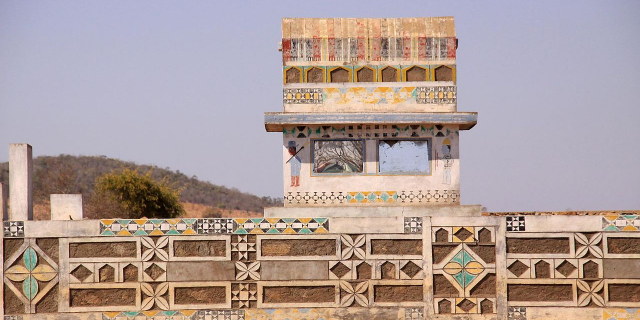

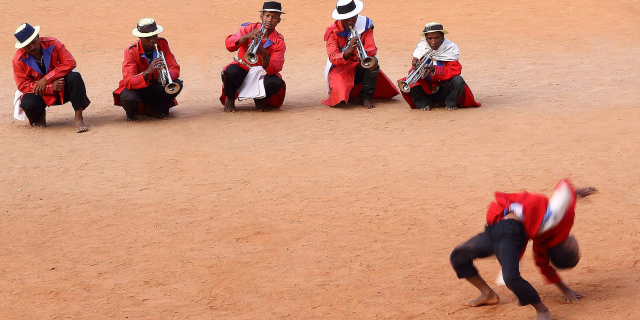

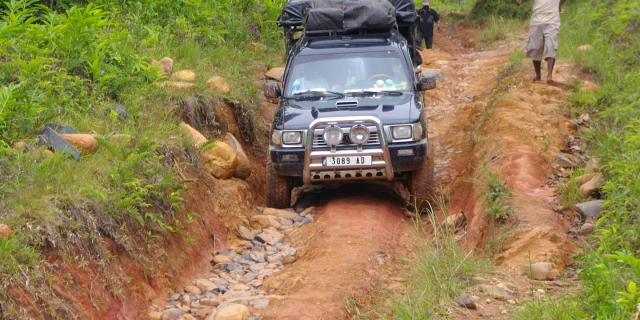

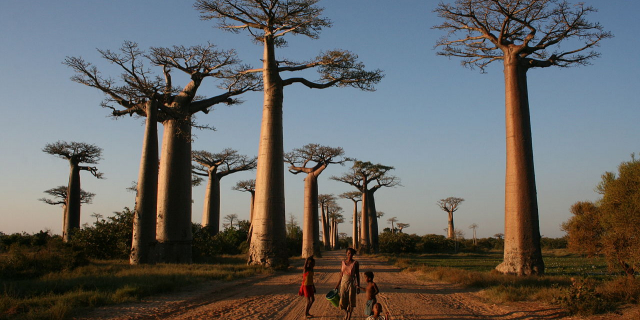

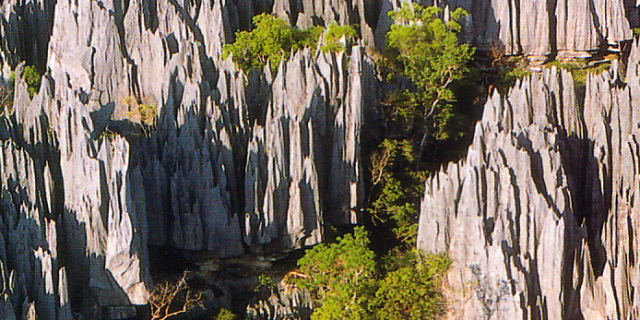
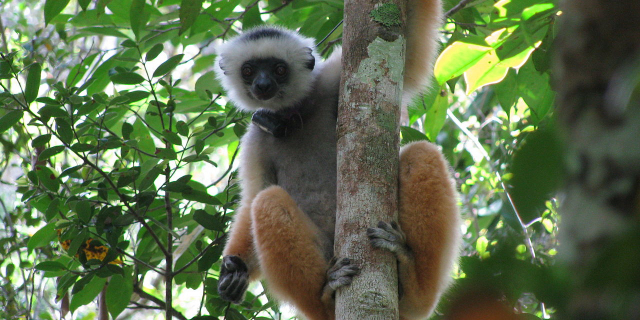

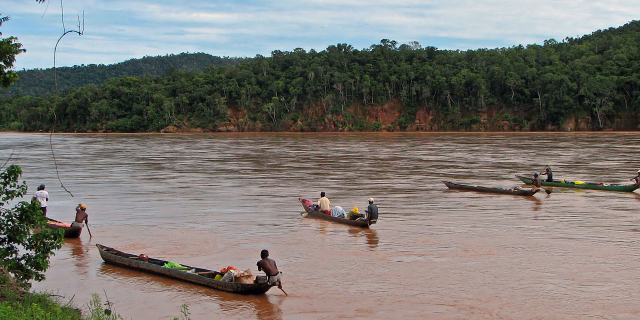
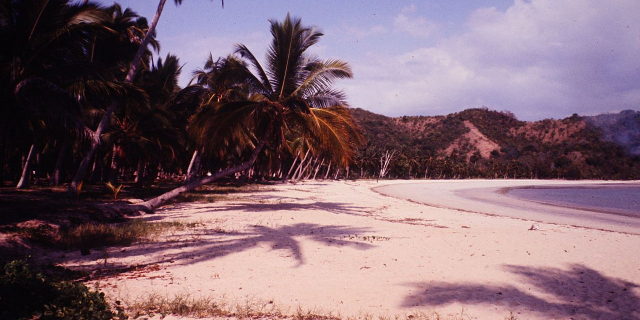

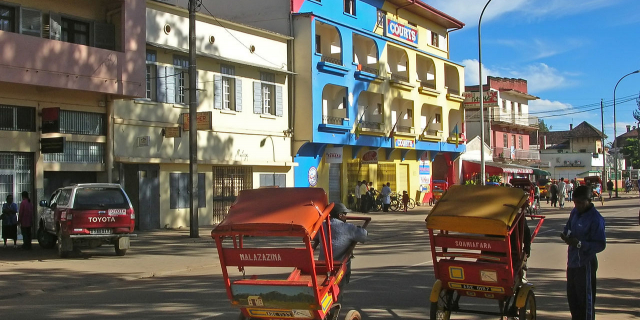


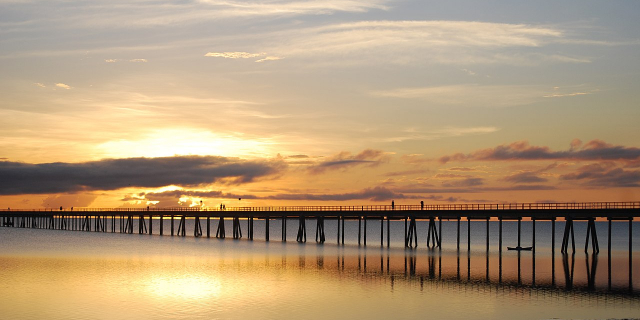

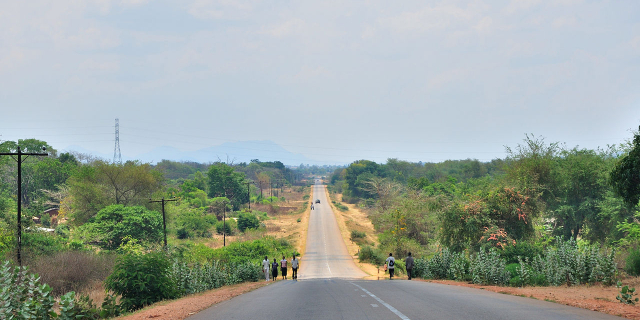



![Cliff Kemper[2] - CC BY-SA 2.0](/sites/default/files/styles/640x320/public/2022-03/Serengeti_gazelles.jpeg?h=ead717b0&itok=JsZMti_M)






